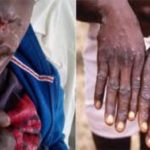Today we talk Frostbite on our Tip Off segment. Does that sound big to your hears? Well, we tend to close our hears to
certain information sometimes believing that such subject area may not be useful because this is Nigeria or just because
no one is talking about it and become dumbfounded when such information starts trending. Imagine a deposit of small
white ice crystals forming in your fridge when the temperature falls below freezing. That is how best to describe
Frostbite in my own view. Now relating that to a very cold weather, say Harmattan, for instance. Do you know how
intense that would be? Yeah exactly! This is not to heighten your tension like I like to say. It is not that deep.
Frostbite only occurs when tissues freeze. This condition happens when you are exposed to temperatures below the
freezing point of skin. Staying outside for too long can result in frostbite and hypothermia. Hypothermia is when the
body loses heat faster than it can produce heat, causing a dangerously low body temperature. This can occur at any
temperature lower than normal body temperature. Frostbite occurs when the skin freezes as a result of low
temperatures, wet clothes or even forceful winds. Frostbite is often accompanied by hypothermia. For example, a
temperature of 0 and a wind speed of 15 miles per hour creates a wind chill temperature of -19. Under these conditions,
frostbite can occur in just 30 minutes.
Frostbite symptoms according to research include a loss of feeling and lack of color. Fingers, toes, earlobes, cheeks and
nose have the greatest exposure to cold and are most likely affected. You know most of the times our body works hard
to keep internal organs and our head warm but sometimes extremities get left behind. Frostbite is said to be a clinical
diagnosis. Medical definition of Frostbite known as freezing cold injury (FCI) is damage to tissues from freezing due to
the formation of ice crystals within cells, rupturing the cells and leading to cell death.
According to research, frostbite has been in existence for centuries. It used to be a military problem, but now applies to
civilians and most people who get frostbite are males between the ages of 30 and 49. I’m pretty sure it’s not prevalent in
Nigeria but research revealed that everyone is susceptible including children and people living in cold climates for most
of their lives
How do you spot frostbite? Skin becomes hard. It looks shiny or waxy. When the skin thaws, blisters filled with fluid or
blood form. There is also a staging system similar to burns. This is at the advanced level stage where Frostbite goes
through several stages of about four. In the first degree, there is numbness, central pallor, surrounding
erythema/edema, desquamation, dysesthesia. Second degree injury includes: skin blistering with surrounding
erythema/edema. Third degree injury – tissue loss involving entire thickness of skin, hemorrhagic blisters. Fourth degree
– tissue loss involving deeper structures, resulting in loss of the affected part (ncbi.nlm.nih.gov) Frostbite injuries could
be cured by using a new spray-on medicine, according to scientists (dailymail.co.uk/)
All these can be prevented by the way. Prevention is as easy as ABC if you practice them
1. Dress In Loosely Layered Clothing: tight clothing raises your risk of frostbite. Instead, choose loose layers that allow
body heat to get around. For instance, wear material that helps keep you dry. They should be made of an insulator like
wool or fleece. These materials should be wind- and waterproof. You can wear them in the order of first being worn on
top of second and second worn on top of third. That’s called dress for excess
2. Stay hydrated. Never think because it is cold you may not need to drink enough water. Even if you are not thirsty,
drink at least one glass of water before you head out. If you stay dehydrated, you are increasing your risk of developing
frostbite so you got to drink some water mahn! You could even have sports drink but stay off alcoholic drinks. All you
need is both food and fluids to fuel your body and keep you warm.
3. Limit your exposure to cold and go indoors if there is any doubt you are too cold. Check on your children at regular
intervals to inspect fingers and noses for signs of frostbite.
4. If you are away from home, take extra clothing along. It’s been said that the “best way to prevent frostbite is to dress
warmly and move indoors once your fingers or toes begin to feel cold. Always keep your hands and feet dry and your
ears covered.” (medicinenet.com)
Perhaps this is a way of preparing you ahead of Harmattan season which usually occurs between the end of November
and the middle of March. Comparing frostbite to Harmattan which is actually comparable in higher latitudes, your skin
can be very dry and can be very challenging due to very cold temperatures just like you struggle through mornings and
nights and very hot weather in the afternoons during Harmattan due to intense weather.
I don’t take Lagos harmattan seriously as it can hardly be felt but this for the benefit of others fans in different parts of
Nigeria: North, East, South, West, African and the world at large. Visit our website theboxshowafrica.com to catch up.



